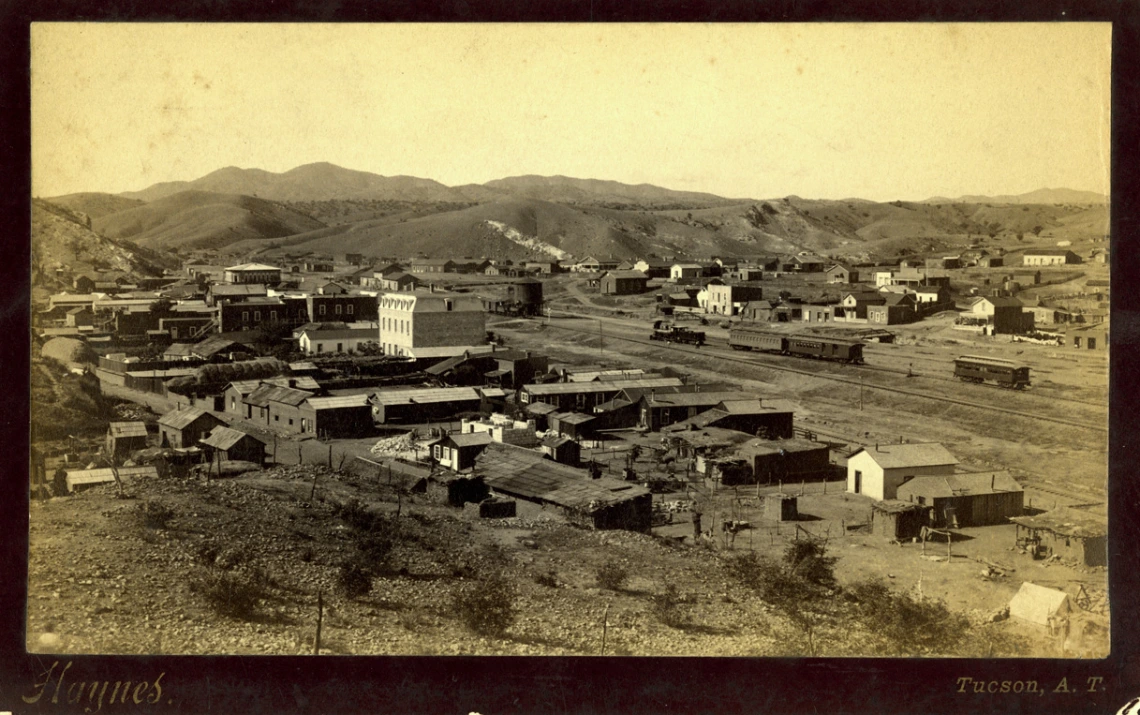Arizona, Southwestern, and Borderlands photograph collection

View of Nogales taken from above the city. The railroad is at the center of the photograph.
Photo by Willis P. Haynes.
Collection area: Borderlands Arizona and Southwest
Collection dates: 1873-2018 bulk 1920-1970
The files generally fall into the categories of Arizona and New Mexico cities and towns, military posts, and other places; Tucson, Ariz.; Indians of Arizona, New Mexico and Mexico; Mexico; and individual people.Formats include postcards, stereographs, cartes-de-visite, cabinet cards, cyanotypes, viewbooks, and photoprints.
Cities and towns is a heading as well as folders under the names of individual cities and towns. These are often 19th and early 20th century images of celebrations, businesses, buildings, mining activity, floods, and churches. Tucson (Ariz.) is well represented and includes categories such as Tucson (Ariz.)-Architecture, Domestic (including images of some well-known homes), Businesses, Buildings, Clubs,
Hospitals, Neighborhoods, Schools and Urban Renewal. In addition to Tucson, Bisbee, Douglas, Globe, Phoenix, and Tombstone are also well-represented. Other places include military posts such as Fort Grant
(Ariz.) which includes images of the Corbusier family between 1887 and 1905, picnics, a wedding party, the 14th Cavalry Band, and a few African American 10th Cavalry soldiers. New Mexico places are also
present. National parks and monuments are also represented under their names.
The Mexico series is particularly strong. It includes images of the Mexican Revolution including the Mexican Army, Revolutionary Army, U.S. Army and U.S. Navy; and cities and people of Mexico including Cananea, Ciudad Juarez, Guaymas, Guadalajara, and Nogales. These are filed directly as in Mazatlan (Sinaloa, Mexico)--Carnivals, 1900-1920 or Mexico--History--Revolution, 1910-1920 (Bands (Music) Rurales).
Under the broader category of Indians of North America and Mexico are found folders for individual tribes including Apache, Hopi, Maricopa, Navajo, Tohono O'odham, Yuma, and Yaqui as well as New Mexico and Mexico native peoples. In addition to subjects such as Dwellings, Basket making, Children, Women, and Men, sometimes individual people are listed for example as Apache Indians--Portraits--Bonito. Highlights
in this series are Apache Indians-San Carlos Indian Reservation (Ariz.), Hopi Indians-Rites and ceremonies, and Indians--Tohono O'odham-Indian Achievement Days (showing Home extension fairs, 1930-1934).
Many other folders are under subjects such as Mines and Mineral Resources, Railroads, Ranches, Cowboys, Aeronautics, Automobiles, and so on. The Miami Copper Company is well represented with
images of buildings, machinery, railroads, people, and more. Schools--Arizona includes photographs of Home Demonstration activities and children's activities at Indian and rural schools in Greaterville, Vail, Jaynes Station, Sonoita, etc.
The People category lists people alphabetically under the main heading of People. Many of these images are studio portraits from a Douglas, Arizona photographer, taken between 1917 and 1918, and identified
with the person's name. Well-known state and local individuals are also included. These include the Earps, Jeff Milton, Tom Mix, John Slaughter, Nelson Miles, Bruce Babbitt, the Wakefield family, the DeConcini family, and many others. Some individual files contain more than portraits. Edward R. Monk's file has cattle ranching images from his Willcox, Ariz. ranch. B. F. Ord's file has family photographs and
Fort Grant officers and wives. Ada P. McCormick's file includes women's activities during World War II, and Margaret Sanger's file includes images of birth control hearings.
Another format, which is listed both within the master list and separately at the end, is the Small Collections-Portfolio Boxes. These are arranged in the same format as the photograph files but they are
filed separately in the Vault. They include photograph albums and small collections by person, place or subject. Several are scenic views of Arizona places including the Grand Canyon, some are Indians--North
America--Hopi Indians villages and ceremonies. Mexico is well represented and the Mexican-American Border Region--History--20th Century has albums from Camp Harry Jones near Douglas, Ariz. and the New York National Guard stationed along the Rio Grande River. Photographs under Navajo Indians-Schools (Navajo Methodist Misson School) Portfolio Box (Vault) depict the life of students at the school in New Mexico circa 1954-1955.
The Panorama format contains panoramic photographs of mining towns such as Ajo, Bisbee, Ray, and Jerome, and military camps in Douglas and Nogales, Ariz. and El Paso, Texas as well as some town views.
Early Arizona photographers are represented throughout the collection and in some cases are listed in the guide. These include the Buehman Studio, F. A. Hartwell, D. P. Flanders, William Henry Jackson, George
Wheeler, W. H. Williscraft, George Rothrock, E. A. Bonine, W. E. Hadsell, and Willis Haynes.
The Photograph subject files were created and added to by Special Collections staff members, over the years, from donations received from various sources, in order to provide subject access to these photographs within Special Collections holdings.
A collection guide explains what's in a collection. New to using our collections? Learn how to use a collection guide.
Collection guideThe collection has materials you can access online.
Access this collection
Visit us in person to access materials from this collection. Our materials are one-of-a-kind and require special care, so they can’t be checked out or taken home.
How to cite
Learn how to cite and use materials from Special Collections in your research.
